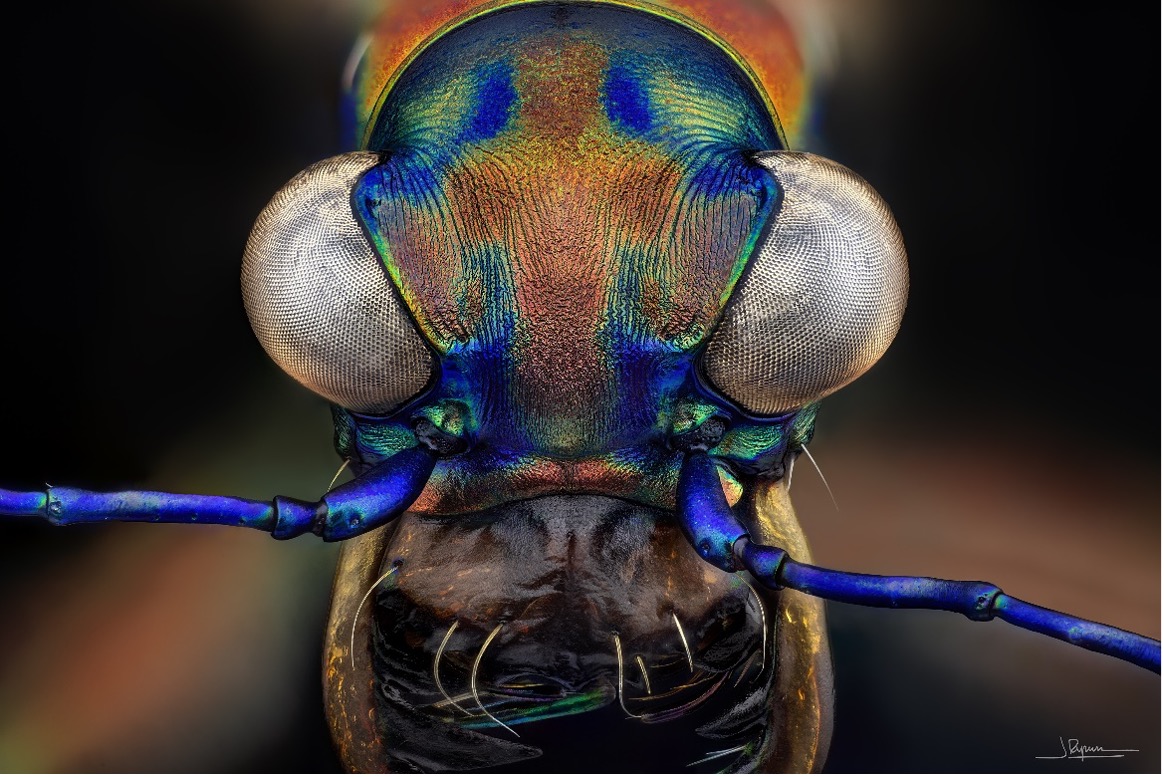Ever wondered what a moth looks like under the microscope? Then take a look the image that won for the Europe, the Middle East, and Africa (EMEA) region in our Global Image of the Year 2022 competition! Javier Ruperez from Spain beautifully blended art with science when he captured the wing scales of a moth that closely resembles a butterfly. We spoke with Javier to learn more about his winning image and how he reveals small masterpieces of nature through light microscopy.
Q: What does your winning image show?
Javier: The image shows the detail of the wing scales of the moth Urania rhipheus (Chrysiridia rhipheus), also known as the Madagascan sunset moth. It is an interesting daytime flight moth. Unlike most butterflies, the colors of its wings do not come from pigments but are structural colors generated by its iridescence.

The Image of the Year 2022 EMEA winning image shows scales of the wing of the Urania rhipheus moth. Captured at 20X by Javier Ruperez.
Q: What do you find exciting about the image and subject matter?
Javier: The most interesting thing about this image is the up-close look at the colors in the scales of the moth’s wings. They are not pigmentary but are produced by the optical phenomenon that is generated when its wings reflect light.
Its colors are produced by the conjunction of two optical phenomena, caused by the structure of the scales and their shape. Each scale is made of alternating layers of chitin and air that interfere with light. The chitin layers are held in place by blocks that maintain a space between them. These air-filled layers and gaps are thinner than the wavelength of visible light. This structure strongly reflects certain wavelengths of light, depending on the number of layers, their thickness, and the angle of incidence of light. The scales are also strongly curved, which causes a phenomenon of reflection between them.
Consequently, when light hits one scale, it reflects off at an angle of about 90 degrees and hits the next scale, and so on across the wing. Since the angle of each reflection is far from the normal incidence, the interference effect causes the reflection of different colors that become visible when the light hits the upper curved part of the scales and is returned outwards. That’s why this phenomenon is often studied by optical science—it also has numerous applications in real life.
Q: How did you create the image?
Javier: I created the image in the my home studio using equipment that I assembled. I used a reflex camera connected to a bellows. Through various adapters, I connected the equipment to an Olympus LMPlanFl 20X 0.40 BD objective, adding a macro conversion lens that acts as an intermediate tube lens, as the microscope objective is corrected to infinity.
To make the image, I used the technique of focus stacking using a high-precision electronic displacement rail. I took a total of 215 images with a displacement of 3.59 microns between each one. Then I joined all of them in a single fully focused image through specialized software, saving the almost non-existent depth of field due to high magnification (20X).
Q: What challenges did you encounter when capturing this image?
Javier: The biggest challenge was to diffuse the lighting enough so that parts of the iridescent light reflected from the scales were not burned in contrast to the darker parts, which creates a challenge with the stacking software used to join the images. But with patience and my experience with the various homemade diffusers I created, I achieved a correct diffusion of the reflected external LED light.
Q: Why did you choose this image as your entry for the Image of the Year competition?
Javier: It is an interesting image beyond its visual impact due to the striking colors in the structures of the wings of this moth. In addition to its artistic value, it has an important scientific value and adapts to the spirit of the Image of the Year contest. It can encourage people around the world to look at these types of images in a new way and appreciate the beauty created by nature that is hidden from our eyes.
Q: Is there a message about the image that you would like to share?
Javier: I have been taking pictures of the wing scales of many different butterflies and moths in the world for some time, and I find it a fascinating world. Lepidoptera are messengers of ephemeral beauty, their wings reminding us that even a fleeting moment can be amazing.
The scales of their wings not only serve as a fundamental part of their aesthetic, but also have a role in their behavior. Some butterflies use scale patterns to camouflage themselves in their environment. Others develop bright, bold colors as warning signs to potential predators. They are small masterpieces of nature, each unique and integral to the wonderful diversity and adaptation of these creatures. Their variety and complexity add depth to our appreciation of the beauty and biology of butterflies.
Q: Where and when did you first learn to use a microscope?
Javier: I have no scientific training, but I am an advanced amateur in using microscope objectives for microphotography with adapted external components. I've been doing this type of photography for about 10 years. I like to investigate what I photograph—mainly the world of insects—which is the type of photography that fascinates me.
I use a simple binocular microscope to visualize samples. Then the photographic work is done with microscope objectives of different magnifications, which I adapt to my photographic equipment in an artisanal way. I have diverse lenses from different brands.
For 20X magnification, I may use the Olympus LMPlanFl 20X 0.40 BD models or the Olympus MPlanFL N 20X 0.45. Both have a great optical quality due to the optical glass used with fluorine elements. The optical corrections perfectly correct the chromatic aberrations that may exist, which is fundamental to my work. With one of these two lenses I made the winning photograph of the contest, which demonstrates its optical excellence.

Close-up image of a Cicindela aurulenta, also known as a blue-spotted or golden-spotted tiger beetle. Image courtesy of Javier Ruperez.
Q: When did you become inspired to use microscopes to create art?
Javier: I had done conventional macro photography before. Thanks to the work of other photographers, I realized the possibilities offered by microscope lenses adapted to today's digital cameras. You can delve into other worlds within our reach, with a quality that cannot be compared to what was seen before. Now I can access that hidden world full of shapes and colors and see beings so close that they seem from another planet.
Q: What do you find most fascinating about microscopy?
Javier: The possibility of entering unknown worlds that are part of our world. Something seemingly ordinary can result in breathtaking beauty when seen through a microscope.
Photography using microscope objectives awakens in me a unique and amazing fascination. Through objectives, the world is transformed into a stage of hidden wonders, revealing details and textures that the human eye can hardly imagine. Each image is a window into a tiny but infinitely complex universe, where the structure of everyday beings unfolds in a dance of surprising shapes and colors that my camera can capture. This takes me into the unexplored, reminding me every day of the immense beauty it can hold, and how even the tiniest thing can contain unexpected greatness.
Q: Does your profession intersect with imaging? Or is this more of a hobby, art form, passion for you?
Javier: Professionally I am a civil servant of the administration, so it has little to do with my passion for photography. My dedication to microphotography is more of a hobby. As I dedicate many hours each day to it, I would say that it is a passion.
Q: What are you currently working on artistically?
Javier: Every day I take photographs of insects and arachnids, which has enabled me to enter the exciting world of entomology. My photographs are published in many media outlets around the world, which gives me great satisfaction. Now I am preparing an exhibition in Spain about my work. I hope it will be a success and can be seen in other parts of the world in the future.
Q: Is there anything else you would like to share?
Javier: The photographic work I do on the world of insects may be interesting to nature lovers. You can see it at javier-ruperez.com and on my Instagram account: @quenoteam.
What’s Next for Image of the Year
Our next Global Image of the Year contest is just around the corner, so stay tuned to learn more! In the meantime, check out our interviews with the Americas winner and materials science winner to explore other winning images.
Related Content
Image of the Year 2022 Americas Winner Captures the Art of the Natural World
Art of Chemistry: Meet the First IOTY Materials Science Award Winner
Breadth of Beauty—Our Most Popular Microscope Images for August 2023


